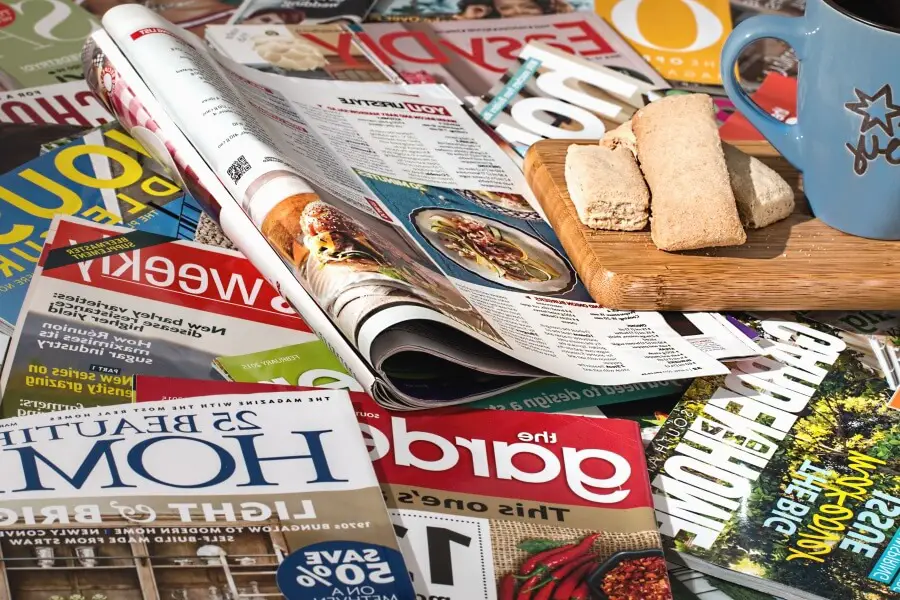Newspapers are compostable are safe for organic gardens. Feel free to add those old newspapers to your compost pile. Only remember to shred them first and mix them with other brown and green composting material.
Just thinking it through, a newspaper is basically processed wood pulps, which we know are brown materials, and a good source of carbon for the soil. But are processed wood pulps safe in a compost heap? What about the ink? Is it harmful to the soil?
How do you compost newspapers?
It’s easy, so read on.
Table of Contents
Can You Compost Newspapers?
Newspapers are a good source of carbon once they decompose, and you don‘t need to worry about the ink. It‘s not toxic to the soil.
Composting newspapers is an easy way to boost your soil with enough carbon, which helps to improve the soil’s water retention capacity and structure. Moreover, making newspaper compost is cheap since papers are locally available on a large scale.
The only downside is that newspapers take more time to decompose due to the presence of lignin. Lignin is found on the walls of plant cells, and it helps maintain the rigidity of the plant cell.
However, you should be careful not to add glossy magazines to the pile. Glossy magazines contain heavy metal ink, which can affect your garden soil’s biodiversity. These heavy metals are also considered harmful to both plants and man.
Is Newspaper Safe For Organic Gardens?
The major concern for most organic farmers is whether the chemicals used in making newspapers are safe for agriculture.
Research by ATTRA has shown that there’s no need to worry. It‘s safe to make newspaper compost for organic farming, and it‘s safe even for mulching.
Initially, newsprint was whitened by bleaching with chlorine, which is known to be toxic when it accumulates in the soil.
However, better alternatives have been sourced. So now, instead of using chlorine, hydrogen peroxide is used. It’s much safer and has benign effects on the soil structure.
Research shows that soil microbes release enzymes that help them digest newspaper without any side effects.
What about the ink on the paper: Is it safe for organic farming?
The ink is harmless to the soil. It also emits fewer toxins when processing.
The heavy metals initially used to make newspaper inks have now been replaced with more environmentally friendly inks, such as soy ink, which is made from soybean oil.
In addition, shredded papers make good bedding for worms if you‘re using a worm bin for vermicomposting.
Which newspaper is best for composting?
The average daily newspaper will do. You can even add unprinted cardboard to the pile.
The standard newspaper is safe for composting as it contains no heavy metal in its ink, and hydrogen peroxide is used for bleaching, which has little effect on the soil compared to chlorine.
What Kind Of Newspapers Not to Compost?
Regarding which paper is best for composting, you need to consider the type of ink used and the bleaching chemical used on the paper.
I know you can’t do this at home, and it‘s awkward calling the paper manufacturers to ask about which bleaching agents they use.
To help you out, I’ll list the papers you must avoid in your compost.
1. Glossy papers
These attractive papers are laminated with petrochemicals to make them shine; however, once in the soil, they take years to biodegrade. Also, the color inks used in glossy papers are mostly heavy metals and can alter the soil structure by affecting the microorganism.
2. Office papers
It’s also best you avoid office papers in your compost heap. They mostly contain traces of chlorine, which can harm your garden plants.

How Do You Make Newspaper Compost?
Making a newspaper compost is quite easy.
You need the following:
- Brown material. They include cardboard, dead leaves, or sawdust.
- Vegetable scraps, grass clippings, coffee grounds, food scraps, or other green material. They’re a source of nitrogen.
- Water
- A composting bin
- A pitchfork for turning the manure
A good compost pile needs to be well aerated because the soil microbes need oxygen to break down the composting materials.
To achieve this, you need to reduce the papers into leave-side pieces or use a paper shredder.
Also, newspapers can absorb a lot of water, therefore, ensure the compost remains moisturized by adding water to it.
Step-By-Step Composting
Step 1.
Position the bin in a well-drained place and with adequate sunlight. Prepare the brown materials by mixing the shredded papers with dead leaves or sawdust.
Then, place the brown materials at the base of the bin. They act as a bulking agent to absorb excess moisture from the green materials.
Step 2.
Mix the veggies with the food scraps for the green materials. Adding crushed eggshells to the mixture boosts calcium content in the compost.
Now, place the green material mixture on top of the brown material.
The brown and green materials should be in layers. The layers should be about 15 cm thick. As you put the materials, use a hose pipe to wet the layers.
The compost should have enough moisture. But avoid overwatering.
Step 3.
Once the bin is full, use a pitchfork to turn and mix the organic matter. Alternatively, if the bin is round, seal the top and roll it back and forth to mix the content.
Step 4.
Seal up the bin and wait for the microbes to do the rest. Check the compost at least once a week to see if it has moisture, and turn the compost for aeration.
Turning the compost also helps to avoid the slow and smelly anaerobic decomposition.
Add already decomposed organic material to the newspaper compost to speed up the composting process.
Generally, the compost should be ready after 4-6 weeks.
How Long Does It Take For Newspaper To Decompose In Soil?
Mostly, a newspaper in soil takes about 6 weeks to decompose.
Various factors determine the rate at which a newspaper decomposes in soil.
These factors include:
- The type of paper. Glossy papers take more time to degrade than normal newspapers because glossy papers are laminated with petrochemicals, which take longer to decompose.
- Availability of oxygen in the soil. If the soil has enough oxygen, then the microbes can digest the paper at a higher rate.
- Climate condition. Exposure to rain and sunlight quickens the decomposition rate.
- Presence of paper-eating insects. A newspaper in soil with worms and bugs will decompose faster.
How Much Newspaper Do You Put In Compost?
A compost heap should have a balanced ratio of brown and green material. The appropriate balance should be a 30:1, that‘s brown to green material ratio.
Knowing the required ratio will help you estimate how much newspaper you‘ll need for your compost.
A 200 kg compost pile should contain about 190 kg of brown material. Remember, the brown material should contain diverse materials such as sawdust and dead leaves.
So, for our 190 kg sample, about 30 kg should be newspapers.
Can I Use Shredded Newspaper As Mulch?
Yes, you can! You‘ll undoubtedly love the shredded newspapers mulch. It’s easy to install, and it‘s biodegradable, meaning after 6 weeks, the soil will be rich in nutrients.
Having newspapers as mulch benefits your plants by reserving water for them and regulating the soil‘s temperature.
To avoid the wind blowing away the papers, pour water on the newspapers to stick together and with the soil.
Does Putting Newspaper Down Stop Weeds?
Yes, covering the garden surface with newspapers does suppress weeds from growing by cutting off sunlight.
For better results, add 3-4 inches of dry leaves or sawdust to keep the papers in place.
Unlike plastic weed suppressors, newspaper allows water to penetrate, so your plants remain nourished.
So, you can do more with a newspaper than reading it. You can make compost out of it. Newspapers are brown materials and are a good source of carbon. Worry not about the ink. It’s soybean oil and harmless to soil and plants.
Making newspaper compost is easy and only takes 4-6 weeks to be ready. However, not all newspapers should go into a compost bin.
Avoid office and glossy papers; they contain heavy metal ink and chlorine compounds, which are toxic to garden soil and plants.

